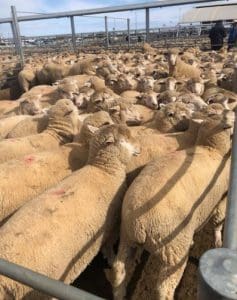
The Spackman family’s $300-plus lambs at Forbes.
RECENT high prices for Australian lambs reflect a constrained supply, especially of quality heavy lambs, but current rates are becoming a challenge for American retail outlets, Meat & Livestock Australia has reported.
MLA has reported that poor seasonal conditions have delayed the influx of new season lambs out of NSW, while international demand for sheep meat, supported by a softer Australian dollar, has supported prices.
China and the United States are leading the way as the largest recipients of Australian sheep meat in 2018. So far this year, sheep meat exports to the US have continued to expand, up 8pc year-on-year, with lamb and mutton exports climbing 5pc and 19pc, respectively. However, limited availability of heavy categories saw lamb exports to the US in August ease 16pc year-on-year, MLA said, although this was offset by increased mutton shipments.
Ever-increasing competition from China has also pressured shipments to the US; in the first seven months of 2018, the US ceased being Australia’s largest lamb export market on a volume basis, although it remains Australia’s most valuable destination, MLA said.
US sheep meat cold store inventories rising
US lamb and sheep slaughter was seasonally lower in late July and August. In the four weeks ending 25 August, US sheep and lamb slaughter averaged 37,600 head a week, 3.1pc higher than the same period the year prior, but 2.4pc lower than the five-year average, MLA said. The lift in domestic supply and the cheaper price of competing proteins (chicken and pork) has resulted in a sizeable increase in sheep meat cold store inventories in July (at 19,000 tonnes, up 55pc year-on-year and 26.5pc above the five-year average).
MLA said US farm gate lamb prices have declined in recent weeks; however, the price of imported product remains historically high, underpinned by the high cost of lambs in both Australia and New Zealand.
US retail outlets will be seeking lower prices in order to move through surplus supplies, as pushing more lamb through retail channels at elevated prices remains a challenge. Loin chops featured heavily at retail in August, accounting for 44% of all lamb features, and prices averaged 8.4% above year-ago levels.
Eastern states’ saleyard lamb prices have fallen dramatically in the past 10 days, but are still at historically high levels. The Eastern States Trade Lamb indicator has fallen by 60 cents from 884 cents to 824 cents, and the heavy lamb indicator has fallen a similar amount from 917 cents to 849 cents, a drop of 68 cents.
Read the latest monthly US Lamb Market Update prepared by Steiner Consulting
Source: MLA.

HAVE YOUR SAY